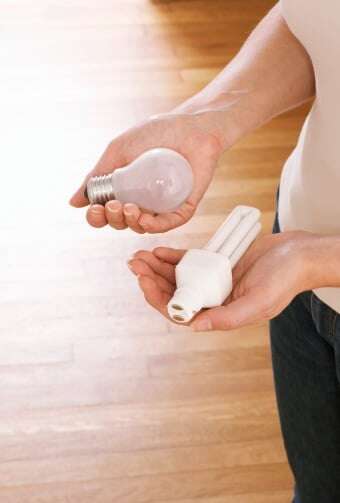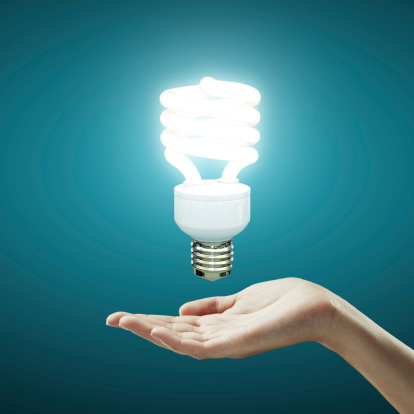 When the sun goes down, the lights go on in most American homes. And when the sun goes down earlier in the fall, the lights go on sooner.
When the sun goes down, the lights go on in most American homes. And when the sun goes down earlier in the fall, the lights go on sooner.
If you're like most American homeowners, between 10 and 15 percent of the energy you consume goes to lighting (about the same amount as you use to power your appliances). If you're looking for ways to reduce your electric bill, now is the ideal time of year to see the light and potentially save hundreds of dollars per year on your bill if you're still using traditional, dome-shaped incandescent bulbs.
Make the switch to energy-efficient bulbs
Switching to energy-efficient lighting is one of the surest, quickest ways to reduce your monthly electric bill. The U.S. Department of Energy says: “Compared to traditional incandescent bulbs, compact fluorescent bulbs (CFLs) can yield as much as 75 percent energy savings and last 10 times longer. You can get even more energy savings, longer life span and less wasted heat by switching to Energy Star” light-emitting diodes (LEDs).
In terms of dollars and sense, the department says that “by replacing your home's five most frequently used light fixtures or bulbs with models that have earned the Energy Star (designation), you can save $75 each year.” And that's just five bulbs; imagine the savings you can reap throughout your entire home, inside and out.
Do energy-efficient bulbs cost more than incandescents? Yes, but they're worth it in the long run. With “regular” use – or about four hours a day – a CFL should pay for itself in energy savings in less than nine months.
Plus, if you tend to procrastinate the task of scrounging for replacement bulbs (what cabinet/drawer/box are they in anyway?), you're in luck: you'll have to rummage around only about once every seven years because that's how long energy-efficient bulbs generally last.
Compare CFLs and LEDS
There's no doubt that CFLs are generally more popular – at least for the time being – than LEDs. But you might wish to compare their respective features before heading to your favorite home store.
With their distinctive, spiraled internal lamp, CFLs look very different from dome-shaped incandescent bulbs. They produce light differently, too. As the department of energy explains: “In an incandescent, electric current runs through a wire filament and heats the filament until it starts to glow. In a CFL, an electric current is driven through a tube containing argon and a small amount of mercury vapor. This generates invisible ultraviolet light that excites a fluorescent coating on the inside of the tube, which then emits visible light.”
This explains why CFLs require more initial energy to light; it takes time for energy to flow through the spiral. This process can take as little as 30 seconds and as long as three minutes, so CFLs require a little patience as they achieve their full brightness. It may help to remember that “good things come to those who wait” – or the 75 percent energy savings they offer over incandescent bulbs.
It would be great if the wattage numbers matched up between incandescent and CFLs, but unfortunately they don't. So replace 100-watt incandescent bulbs with 23-watt CFLs; 75-watt bulbs with 18-watt CFLs; and 60-watt bulbs with 13-watt CFLs.
LED bulbs, meanwhile, are appealing to many people because their projected light is similar to traditional incandescents, but they last about 25 times longer and use even less energy than CFLs.
It may help to regard LEDs in particular as minor investments. But more homeowners appear to be taking the long view on LEDs because they continue to grow steadily in popularity.
Heed other bright ideas
Whichever type of bulb you choose, other “bright ideas” will help you save money on your electric bill:
- Install dimmer switches; lower light levels consume less electricity.
- Capitalize on light from the sun (it's free, after all). For example, arrange computer stations and other reading and work areas near natural sunlight to minimize the time you need to turn on artificial lighting.
- Remember that light colors – especially the color of paint on walls – reflect sunlight (and artificial light) with greater ease than darker colors.
- Use a feather duster to keep dust off light bulbs, lampshades and fixtures. More light – and the light you're paying for – will shine through.
- Install timers on lights that you might otherwise leave on overnight for security reasons. Timers are economical and simple to install.
- Consider Energy Star fixtures, which are built to distribute light more efficiently. Some are even equipped with dimmers.
There is no doubt: when you use less electricity, you'll spend less money on electricity. If our ideas have turned on the proverbial light bulb in your mind, you finally might chill out over your electric bill, too.
Next time you need a local electrician, contact Experts In Your Home!








